Why Most Producers Don’t Fail From Lack of Sales Skill

Let’s set the record straight: most commercial insurance producers don’t fail because they can’t sell. They fail because they don’t plan. They lack process. They don’t follow up consistently—or when they do, it’s weak and generic.
In today’s competitive environment, trust is not built through hard closes. It’s built through consistency. Being present when the incumbent fails. Being available when the buyer is finally ready. Being prepared with insight when everyone else is just pushing a quote.
There’s a major difference between being relentless and being intentional. The former burns bridges. The latter builds them. Follow-up that’s too aggressive erodes trust. But strategic, recurring outreach with value creates credibility and rapport over time.
Redefining the Follow-Up: From “Checking In” to “Delivering Value”
If your follow-up strategy consists of emails that say, “Just circling back to see if you had any questions,” it’s time to reassess. That language screams: “I don’t have anything new to offer, but I hope you forgot to ignore me.”
Follow-up should never be an afterthought. It should be a continuation of the sales conversation—a way to bring new insight, relevant value, or useful reminders into the buyer’s world.
Let’s say you dropped off a mod analysis tool and explained how you could reduce their workers’ comp mod over 12 months. Your follow-up a week later might include:
- A case study of a similar company you helped save $40,000 in mod-driven premium
- A short video explaining deductible credits in general liability
- A custom article you wrote on their industry’s emerging risk trends
- A tool like a claims triage checklist or subcontractor compliance form
This kind of outreach proves you’re watching out for their business—not just chasing a commission. It’s how you position yourself as a risk advisor, not just another quote machine.
How Sales Psychology Impacts Buyer Behavior
Here’s what most insurance producers forget: there is no “Insurance Buying 101” course in high school or college. Most of your prospects are figuring it out as they go, often under pressure or with limited information.
That means they’re more influenced by emotional triggers than you realize. They buy based on fear, trust, confusion, and timing—not just price or coverage.
Your job as a producer is to understand that psychology. When someone says “no,” it doesn’t necessarily mean no forever. It might mean:
- “I don’t understand what you’re offering”
- “Now’s not the right time”
- “I’m afraid to switch because I’ve been burned before”
- “I like my agent and don’t want to hurt the relationship”
If you show up consistently with messages that reduce risk, educate thoughtfully, and show empathy, you’ll be the first person they call when something goes wrong. Because eventually—something will go wrong.
Cadence and Process: The Backbone of a Repeatable Follow-Up System

One of the biggest game-changers in your sales process is having a defined follow-up cadence.
At Florida Risk Partners, our process looks something like this after a marketing drop:
- Day 0: Leave the physical marketing drop with handwritten note
- Day 1: Send personalized email referencing the drop
- Day 2: Follow up with a phone call or voicemail
- Day 4: Share a relevant blog post or case study
- Day 7: Send a custom video message or resource
This 7-day automation repeats every time we enter a new lead into our pipeline. It’s not aggressive—it’s strategic. No pitch-slamming. Just value, education, and presence.
Even if the prospect isn’t ready today, we stay top of mind so when their agent drops the ball—or they get a renewal they don’t like—we’re the natural next step.
How to Use Risk to Drive the Conversation, Not Coverage
Middle market insurance buyers don’t wake up thinking, “Man, I hope someone comes in today and talks to me about my business auto policy.” What keeps them up at night is risk.
And yet, producers constantly lead with coverage and carrier talk, not risk mitigation. This is a mistake.
When you shift the conversation toward how a client experiences and manages risk, you drive value instantly.
Here are three examples:
- General Liability Deductibles: Contractors who self-pay small GL claims are essentially operating with a deductible—but without the credit or loss control support. When you explain that, you immediately position yourself as someone who understands their business, not just their insurance.
- Experience Mod Audits: Most business owners don’t understand the math behind their workers’ comp mod. When you walk them through the factors impacting their score—and show them where their previous broker dropped the ball—it builds instant trust.
- Cyber Liability Framing: Instead of “Do you have cyber?” ask, “What’s your plan when—not if—your business gets hit with a ransomware attack?” That drives urgency without pressure.
When follow-up messages focus on operational risk, not just policy details, you build deeper, more strategic conversations that lead to long-term clients.
Personalization, Messaging, and Trust-Building
In a world where automation rules, personalization is your differentiator.
A templated email with “Dear Business Owner” isn’t going to win business. A message that references their actual operations, claims trends in their vertical, or how their mod compares to industry average—that gets noticed.
Use tools like CRM tags, marketing drop notes, or previous interactions to tailor every message.
Instead of:
“I wanted to follow up on our last conversation…”
Try:
“After our discussion about subcontractor exposure, I pulled together a best practices checklist we’ve used with other landscaping firms to reduce liability—see attached.”
That kind of message says: “I understand you. I care. I’ve thought this through.” That’s how you earn trust and open doors.
What to Do When You Lose the Deal

Most producers ghost a prospect after losing the sale. But top-tier producers lean in.
Follow-up after a loss is one of the most powerful things you can do to earn future business.
Book a meeting—not to resell, but to understand. Ask:
- “What made the difference for you in this decision?”
- “Is there anything I could have done better?”
- “What would have made working with us more comfortable?”
Not only does this give you intel to improve your pitch, it also keeps the door open for future opportunities. One of our longest-tenured clients came from a post-loss lunch. No agenda. Just a conversation. A year later, when their incumbent dropped the ball, we got the call.
Tools and Automation (But Only After You Prove It Works)
There’s no point automating something that doesn’t convert manually.
Start by building your follow-up system on paper or with simple tools like spreadsheets and calendar tasks. Once you’ve proven your messages resonate, you can scale with automation.
Platforms like:
- HubSpot (for sales and marketing sequences)
- AgencyZoom (for insurance-specific workflow automation)
- ChatGPT (for scripting value-focused emails and objection responses)
These tools make it easier to stay top of mind without having to remember every step. But the message still matters. Don’t confuse automation with authenticity—you still need to care about every single touchpoint.
Final Thoughts: The Power of Patient Pressure and Preparedness
In the end, insurance producers who succeed in the middle market don’t do so because they have the lowest quote or slickest pitch. They win because they are present, patient, prepared, and persistent.
They:
- Build follow-up systems that educate, not agitate
- Craft messaging that’s personalized, not generic
- Show up when everyone else disappears
- Focus on risk and relationships more than rate and renewal
And most importantly, they play the long game.
If you’re tired of ghosted leads, stalled quotes, and price shoppers, shift your mindset. Turn your follow-up into a process rooted in strategy, risk awareness, and empathy.
That’s where trust is built. And trust is what closes deals.
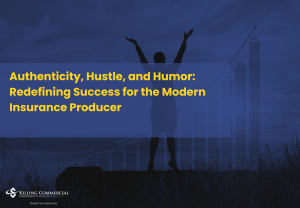
Authenticity, Hustle, and Humor: Redefining Success for the Modern Insurance Producer
The insurance industry isn’t known for flash or flair. Most people picture gray suits, paperwork, and words like “renewal,” “loss runs,” or “premium audit.” But a new generation of producers is proving that this business doesn’t have to be boring. They’re showing that authenticity, energy, and creativity can make insurance not only engaging but a platform for meaningful connection and career fulfillment.
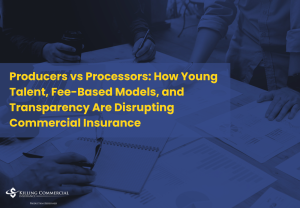
Producers vs Processors: How Young Talent, Fee-Based Models, and Transparency Are Disrupting Commercial Insurance
The world of commercial insurance is evolving rapidly. It’s no longer just about quoting policies and hoping for renewals. Today, producers have the opportunity to lead with value, bring strategy to the sales process, and create long-lasting client relationships that transcend policy pricing.
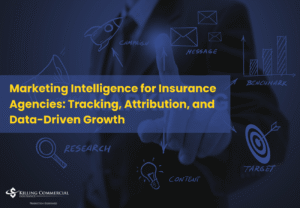
Marketing Intelligence for Insurance Agencies: Tracking, Attribution, and Data-Driven Growth
In the ever-evolving world of commercial insurance, marketing has become a critical lever for growth. Yet most agencies still struggle to understand what’s actually working. From websites that generate leads with no attribution to CRM systems that silo vital data, insurance agencies are often flying blind.
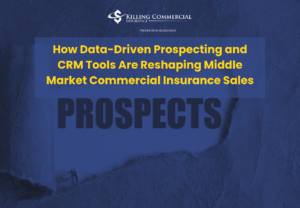
How Data-Driven Prospecting and CRM Tools Are Reshaping Middle Market Commercial Insurance Sales
If you’re a commercial insurance producer trying to grow in the middle market, you’re probably aware that the old-school prospecting methods—cold calling hundreds of businesses, dropping off trinkets, hoping someone is “coming up on renewal”—are no longer enough. In today’s competitive environment, success isn’t about how many people you reach. It’s about reaching the right people at the right time with the right message.
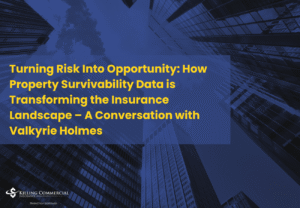
Turning Risk Into Opportunity: How Property Survivability Data is Transforming the Insurance Landscape – A Conversation with Valkyrie Holmes
Too many agents stop learning once they’ve earned their license. The bare minimum—meeting continuing education requirements—is not enough in today’s climate. Producers often resort to online forums, asking where they can complete CE hours “as quickly as possible.” This mindset directly impacts their ability to communicate complex subjects like reinsurance or risk modeling to clients in an understandable way. As a result, they struggle to retain accounts and close new business in an increasingly competitive market.
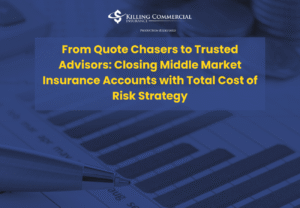
From Quote Chasers to Trusted Advisors: Closing Middle Market Insurance Accounts with Total Cost of Risk Strategy
The problem? Too many producers are pitching too soon, to the wrong people, with nothing more than a quote to offer. This article walks through how to close more business by positioning yourself as a trusted advisor, selling Total Cost of Risk (TCOR) outcomes, and using a structured approach to differentiate at every stage of the sales process.

Responses